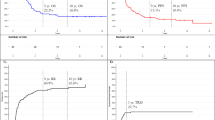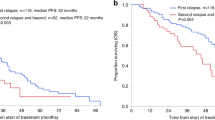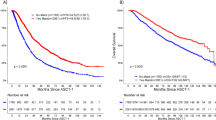Abstract
Previous studies have shown that obtaining complete hematologic remission (CR) in multiple myeloma is an important predictor of PFS and OS. This applies both to autologous and allogeneic transplantation. However, the importance of CR obtained before vs after second transplant or following allogeneic vs autologous transplantation is not clear. We investigated the role of CR analyzing data from the EBMT-NMAM2000 interventional prospective study comparing tandem autologous/reduced intensity conditioning allogeneic transplantation (auto/RICallo) to autologous transplantation—single or double (auto/auto). Allocation to treatment was performed according to availability of a matched sibling donor. Cox regression and multi-state models were applied. The long-term probability of survival in CR was superior in auto/RICallo, both comparing groups according to treatment allocated at start (28.8 vs 11.4% at 60 months, P=0.0004) and according to actual administration of second transplant (25.6 vs 9.6% at 60 months, P=0.008). CR achieved before the second transplant was predictive for PFS (hazard ratio (HR)=0.44, P= 0.003) and OS (HR 0.51, P=0.047) irrespective of the type of second transplant. CR achieved after auto/RICallo was more beneficial for PFS (HR=0.53, P=0.027) than CR after auto/auto (HR=0.81, P=0.390), indicating a better durability of CR obtained after an allotransplant procedure.
This is a preview of subscription content, access via your institution
Access options
Subscribe to this journal
Receive 12 print issues and online access
$259.00 per year
only $21.58 per issue
Buy this article
- Purchase on Springer Link
- Instant access to full article PDF
Prices may be subject to local taxes which are calculated during checkout




Similar content being viewed by others
References
Chanan-Khan AA, Giralt S . Importance of achieving a complete response in multiple myeloma, and the impact of novel agents. J Clin Oncol 2010; 28: 2612–26124.
Paiva B, Gutierrez NC, Rosinol L, Vidriales MB, Montalban MA, Martinez-Lopez J et al. High-risk cytogenetics and persistent minimal residual disease by multiparameter flow cytometry predict unsustained complete response after autologous stem cell transplantation in multiple myeloma. Blood 2012; 119: 687–691.
Harousseau JL, Attal M, Avet-Loiseau H . The role of complete response in multiple myeloma. Blood 2009; 114: 3139–3146.
Hoering A, Crowley J, Shaughnessy JD Jr ., Hollmig K, Alssayed Y, Szymonifka J et al. Complete remission in multiple myeloma examined as time-dependent variable in terms of both onset and duration in Total Therapy protocols. Blood 2009; 114: 1299–1305.
Wang M, Delasalle K, Feng L, Thomas S, Giralt S, Qazilbash M et al. CR represents an early index of potential long survival in multiple myeloma. Bone Marrow Transplant 2010; 45: 498–504.
Attal M, Harousseau JL, Stoppa AM, Sotto JJ, Fuzibet JG, Rossi JF et al. A prospective, randomized trial of autologous bone marrow transplantation and chemotherapy in multiple myeloma. Intergroupe Francais du Myelome. N Engl J Med 1996; 335: 91–97.
Alexanian R, Weber D, Giralt S, Dimopoulos M, Delasalle K, Smith T et al. Impact of complete remission with intensive therapy in patients with responsive multiple myeloma. Bone Marrow Transplant 2001; 27: 1037–1043.
Child JA, Morgan GJ, Davies FE, Owen RG, Bell SE, Hawkins K et al. High-dose chemotherapy with hematopoietic stem-cell rescue for multiple myeloma. N Engl J Med 2003; 348: 1875–1883.
Attal M, Harousseau JL, Facon T, Guilhot F, Doyen C, Fuzibet JG et al. Single versus double autologous stem-cell transplantation for multiple myeloma. N Engl J Med 2003; 349: 2495–2502.
Bjorkstrand B, Goldstone AH, Ljungman P, Brandt L, Brunet S, Carlson K et al. Prognostic factors in autologous stem cell transplantation for multiple myeloma: an EBMT Registry Study. European Group for Bone Marrow Transplantation. Leuk Lymphoma 1994; 15: 265–272.
Barlogie B, Tricot G, Rasmussen E, Anaissie E, van Rhee F, Zangari M et al. Total therapy 2 without thalidomide in comparison with total therapy 1: role of intensified induction and posttransplantation consolidation therapies. Blood 2006; 107: 2633–2638.
Gahrton G, Tura S, Ljungman P, Bladé J, Brandt L, Cavo M et al. Prognostic factors in allogeneic bone marrow transplantation for multiple myeloma. J Clin Oncol 1995; 13: 1312–1322.
Bjorkstrand B, Iacobelli S, Hegenbart U, Gruber A, Greinix H, Volin L et al. Tandem autologous/reduced-intensity conditioning allogeneic stem-cell transplantation versus autologous transplantation in myeloma: long-term follow-up. J Clin Oncol 2011; 29: 3016–3022.
Gahrton G, Iacobelli S, Björkstrand B, Hegenbart U, Gruber A, Greinix H et al. Autologous/reduced-intensity allogeneic stem cell transplantation versus autologous transplantation in multiple myeloma—long-term results of the EBMT-NMAM2000 study. Blood 2013; 121: 5055–5063.
Andersen PK, Keiding N . Multi-state models for event history analysis. Stat Methods Med Res 2002; 11: 91–115.
Putter H, Fiocco M, Geskus RB . Tutorial in biostatistics: competing risks and multi-state models. Stat Med 2007; 26: 2389–2430.
Keiding N, Klein JP, Horowitz MM . Multi-state models and outcome prediction in bone marrow transplantation. Stat Med 2001; 20: 1871–1885.
Blade J, Samson D, Reece D, Apperley J, Björkstrand B, Gahrton G, Gertz M et al. Criteria for evaluating disease response and progression in patients with multiple myeloma treated by high-dose therapy and haemopoietic stem cell transplantation. Myeloma Subcommittee of the EBMT. European Group for Blood and Marrow Transplant. Br J Haematol 1998; 102: 1115–1123.
Andersen PK, Perme MP . Inference for outcome probabilities in multi-state models. Lifetime Data Anal 2008; 14: 405–431.
Liu L, Logan B, Klein JP . Inference for current leukemia free survival. Lifetime Data Anal 2008; 14: 432–446.
de Wreede LC, Fiocco M, Putter H . The mstate package for estimation and prediction in non- and semi-parametric multi-state and competing risks models. Comput Methods Programs Biomed 2010; 99: 261–274.
Klein JP, Logan B, Harhoff M, Andersen PK . Analyzing survival curves at a fixed point in time. Stat Med 2007; 26: 4505–4519.
Iacobelli S, EBMT Statistical Committee. Suggestions on the use of statistical methodologies in studies of the European Group for Blood and Marrow Transplantation. Bone Marrow Transplant 2013; 48: S1–37.
Tricot G, Vesole DH, Jagannath S, Hilton J, Munshi N, Barlogie B . Graft-versus-myeloma effect: proof of principle. Blood 1996; 87: 1196–1198.
Aschan J, Lönnqvist B, Ringdén O, Kumlien G, Gahrton G . Graft-versus-myeloma effect. Lancet 1996; 348: 346.
Corradini P, Voena C, Tarella C, Astolfi M, Ladetto M, Palumbo A et al. Molecular and clinical remissions in multiple myeloma: role of autologous and allogeneic transplantation of hematopoietic cells. J Clin Oncol 1999; 17: 208–215.
Corradini P, Cavo M, Lokhorst H, Martinelli G, Terragna C, Majolino I et al. Molecular remission after myeloablative allogeneic stem cell transplantation predicts a better relapse-free survival in patients with multiple myeloma. Blood 2003; 102: 1927–1929.
Kröger N, Badbaran A, Zabelina T, Ayuk F, Wolschke C, Alchalby H et al. Impact of high-risk cytogenetics and achievement of molecular remission on long-term freedom from disease after autologous-allogeneic tandem transplantation in patients with multiple myeloma. Biol Blood Marrow Transplant 2013; 19: 398–404.
Klein JP, Keiding N, Shu Y, Szydlo RM, Goldman JM . Summary curves for patients transplanted for chronic myeloid leukaemia salvaged by a donor lymphocyte infusion: the current leukaemia-free survival curve. Br J Haematol 2000; 109: 148–152.
Klein JP, Szydlo RM, Craddock C, Goldman JM . Estimation of current leukaemia-free survival following donor lymphocyte infusion therapy for patients with leukaemia who relapse after allografting: application of a multistate model. Stat Med 2000; 19: 3005–3016.
Iacobelli S, Apperley J, Morris C . Assessment of the role of timing of second transplantation in multiple myeloma by multistate modeling. Exp Hematol 2008; 36: 1567–1571.
Acknowledgements
We would like to thank Hein Putter (Department of Medical Statistics and Bioinformatics, Leiden University Medical Center) for statistical input and for support through his grant awarded by the Netherlands Organization for Scientific Research (Grant ZONMW-912-07-018 ‘Prognostic modeling and dynamic prediction for competing risks and multi-state models’, LCdW). Other funding (GG): Swedish Cancer Fund; Stockholm Cancer Society; Netherlands Organization for Scientific Research. The funding sources had no role in the design and conduction of the study, nor in interpretation of the data or in decisions regarding writing the report and submitting for publication.
Author Contributions
Conception and design: SI, GG and DN. Collection and assembly of data: All authors. Data analysis and interpretation: SI, LCdW, SS, CM, DN, LG, NK and GG. Manuscript writing: All authors. Final approval of manuscript: All authors.
Author information
Authors and Affiliations
Consortia
Corresponding author
Ethics declarations
Competing interests
UH: Janssen and Binding Site—received personal fees outside the submitted work. SS: Janssen, Celgene and Binding Site– received personal fees outside the submitted work. PC: Celgene—Honoraria. HG: Janssen—advisory board, speakers bureau, research support; Celgene—advisory board, speakers bureau, research support; Novartis—advisory board, speakers bureau, research support; Chugai—speakers bureau, research support; Onyx—advisory board, speakers bureau; Millenium—advisory board, speakers bureau. GG: Fujimoto Pharmaceutical Cooperation Japan—consultant or advisory relationship; Celgene—Honoraria, research funding. The other authors have no conflicts of interest.
Additional information
This work has been presented at the 39th annual meeting of the European society for Blood and Marrow Transplantation, London, April 2013, oral session ‘CLL, MPD, MDS & Myeloma’, and it was presented as deliverable of the WP14 Stem Cell Transplant of European LeukemiaNet (February 2014).
Supplementary Information accompanies this paper on Bone Marrow Transplantation website
Supplementary information
Rights and permissions
About this article
Cite this article
Iacobelli, S., de Wreede, L., Schönland, S. et al. Impact of CR before and after allogeneic and autologous transplantation in multiple myeloma: results from the EBMT NMAM2000 prospective trial. Bone Marrow Transplant 50, 505–510 (2015). https://doi.org/10.1038/bmt.2014.310
Received:
Revised:
Accepted:
Published:
Issue Date:
DOI: https://doi.org/10.1038/bmt.2014.310
This article is cited by
-
Final outcomes of escalated melphalan 280 mg/m2 with amifostine cytoprotection followed autologous hematopoietic stem cell transplantation for multiple myeloma: high CR and VGPR rates do not translate into improved survival
Bone Marrow Transplantation (2019)
-
Allogeneic hematopoietic cell transplantation for multiple myeloma in Europe: trends and outcomes over 25 years. A study by the EBMT Chronic Malignancies Working Party
Leukemia (2016)



